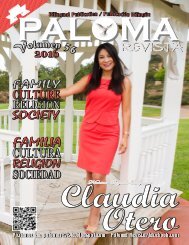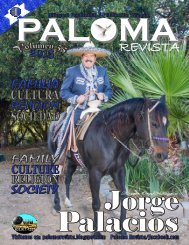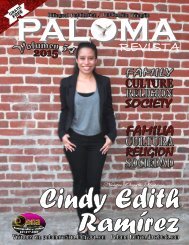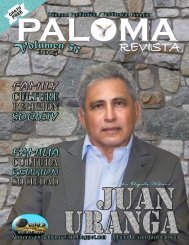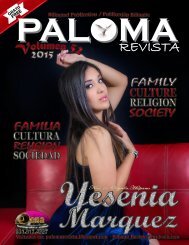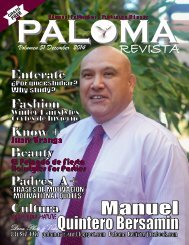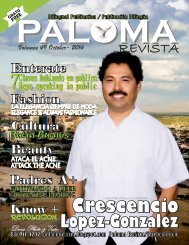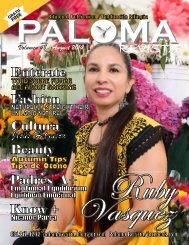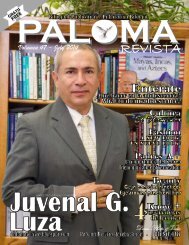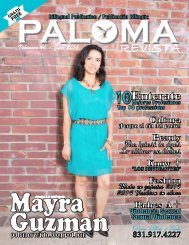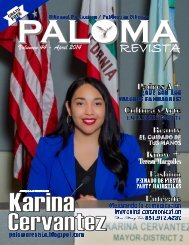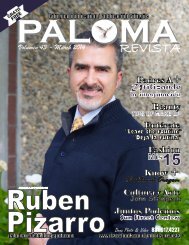Create successful ePaper yourself
Turn your PDF publications into a flip-book with our unique Google optimized e-Paper software.
J o s é M a d r a z o ,<br />
(1781-1859). Fue un pintor y<br />
grabador español, tanto barroco<br />
como neoclásico. Estudió con<br />
Gregorio Ferro, quien le enseña el<br />
estilo y la técnica de la pintura de<br />
Anton Raphael Mengs, en la Real<br />
Academia de Bellas Artes de San<br />
Fernando. A partir de 1803, estudió<br />
en París, con Jacques-Louis David,<br />
donde se formó como verdadero<br />
pintor neoclásico y entabló amistad<br />
con Ingres. En 1806,<br />
Madrazo, convencido<br />
por su maestro<br />
David, partió con su<br />
a m i g o I n g r e s ,<br />
también alumno de<br />
David hacia Roma,<br />
donde completó su<br />
formación, bajo el<br />
gobierno de José<br />
Bonaparte marchó<br />
becado a Roma.<br />
Allí consiguió un discreto éxito.<br />
Durante el período de la conquista<br />
francesa de España, Madrazo,<br />
encontrándose en el extranjero, fue<br />
uno de los primeros opositores al<br />
gobierno de José Bonaparte, por lo<br />
que el pintor español, junto con<br />
otros artistas españoles en Roma,<br />
fue hecho prisionero de los<br />
franceses que había en Roma y<br />
encerrado en el Castillo Sant'Angelo<br />
y luego en la Embajada Española. El<br />
2 de septiembre de 1809 se casó en<br />
Roma con Isabel Kuntz Valentini,<br />
hija del pintor Silesio Tadeusz Kunst.<br />
En 1813, Madrazo fue nombrado<br />
pintor de cámara de Carlos IV. Y,<br />
después, Académico de Mérito de la<br />
Academia de San Lucas. En los años<br />
romanos, José, Madrazo se dedicó<br />
sobre todo a hacer retratos, siendo<br />
numerosas las obras que representan<br />
a artistas y nobles de la<br />
sociedad romana. Obtuvo un gran<br />
poder dentro de los círculos<br />
artísticos con la llegada al poder de<br />
Fernando VII a la caída de Napoleón<br />
I. En 1818, José Madrazo reorganizó<br />
el Museo del Prado. Se ocupó de la<br />
catalogación de las Colecciones<br />
Reales de pintura, que el rey<br />
pretendía colocar en el nuevo Museo<br />
del Prado. Creó para el museo un<br />
catálogo en el que se reproducían<br />
litográficamente todas las pinturas<br />
principales presentes en la<br />
colección. Fue uno de los pioneros<br />
de la litografía, el primero que<br />
introdujo esta nueva técnica en<br />
España. En 1823 fue nombrado<br />
Director de la Academia de Bellas<br />
Artes de San Fernando y seguidamente,<br />
del Museo del Prado.<br />
Iniciaría una larga dinastía de<br />
artistas. Pintores fueron sus hijos<br />
Federico, Luis y Juan, así como sus<br />
nietos Raimundo y Ricardo.<br />
of the first opponents of the<br />
government of Joseph Bonaparte, so<br />
the Spanish painter, along with other<br />
Spanish artists in Rome, was taken<br />
prisoner by the French, in Rome and<br />
imprisoned in Castel Sant'Angelo<br />
and then the Spanish Embassy.<br />
On September 2, 1809 he married<br />
Elizabeth Kuntz in Rome Valentini,<br />
daughter of Silesian painter Tadeusz<br />
Kunst.<br />
In 1813, Madrazo was appointed<br />
painter of Charles IV. And then<br />
José Madrazo, (1781-1859)<br />
was a Spanish painter and engraver,<br />
both Baroque and Neoclassical. He<br />
studied with Gregorio Ferro, who<br />
teaches him the style and technique<br />
of painting by Anton Raphael Mengs,<br />
the Real Academy of Beautiful Arts<br />
of San Fernando. From 1803,<br />
h e s t udied i n P a r i s w i t h<br />
Jacques-Louis David, where he<br />
trained as a true neoclassical<br />
painter and befriendedIngres. In<br />
1806, Madrazo, convinced by his<br />
teacher David, left with his friend<br />
Ingres, also a student of David, to<br />
Rome, where he completed his<br />
training under the government of<br />
Joseph Bonaparte, marched<br />
scholarship to Rome. There he got a<br />
moderate success. During the period<br />
of the French conquest of Spain,<br />
Madrazo, being abroad, was one<br />
Academic Merit from<br />
the Academy of St.<br />
Luke. In Roman, Jose<br />
M a d r a z o w a s<br />
devoted mainly to do<br />
portraits, still many<br />
works representing<br />
artists and nobles of<br />
Roman society. He got a great power<br />
within artistic circles with the rise to<br />
power of Ferdinand VII to the fall of<br />
Napoleon I. In 1818, José Madrazo<br />
reorganized the Prado Museum.<br />
He worked on cataloging the Royal<br />
Collections of paintings, the king<br />
sought to put on the new Prado.<br />
He created a catalog for the<br />
museum in which all major<br />
lithographically reproduced<br />
paintings in the collection.<br />
He was one of the pioneers of<br />
lithography, the first to introduce<br />
this new technique in Spain.<br />
In 1823 he became Director of<br />
the Academy of Fine Arts of San<br />
Fernando and then, from the Prado<br />
Museum. Initiated a long line of<br />
artists. Painters were his sons<br />
Federico, Luis and Juan, and his<br />
grandchildren Raymond and<br />
Richard.<br />
cuando los que mandan pierden la vergüenza, los que obedecen pierden el respeto.<br />
when rulers lose their shame, they who obey lose respect.<br />
44 831.917.4227 familia+cultura+religión+sociedad




